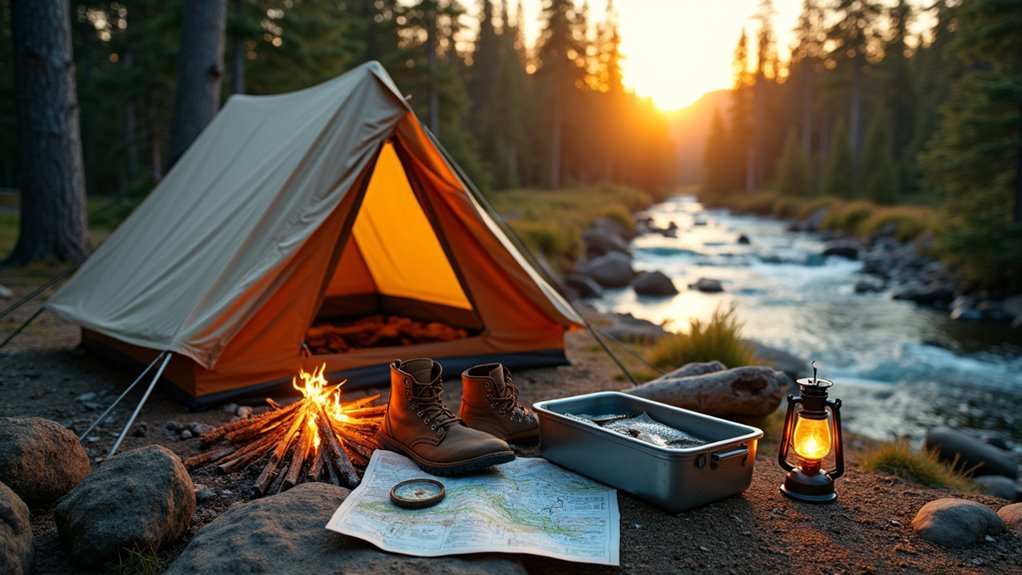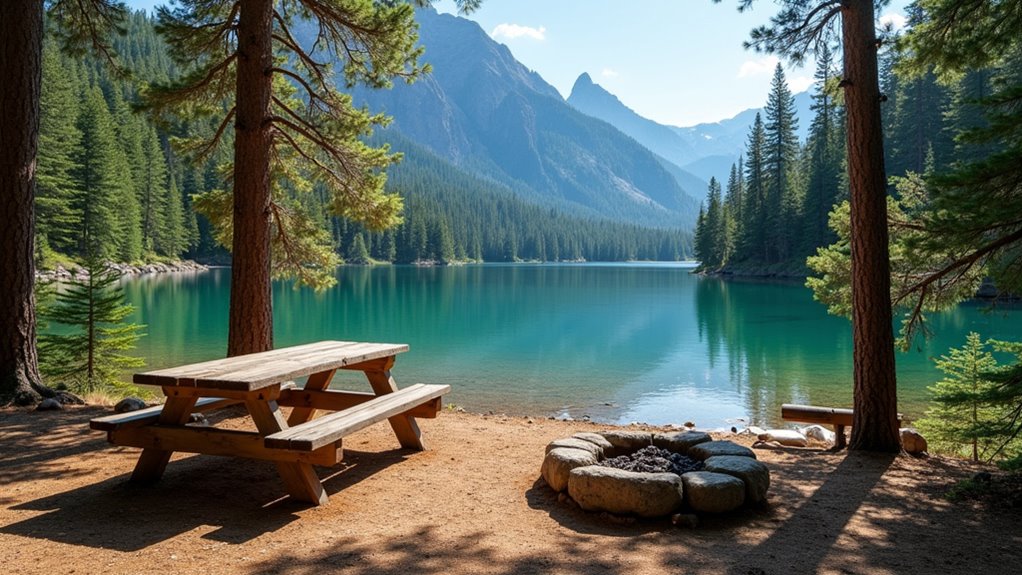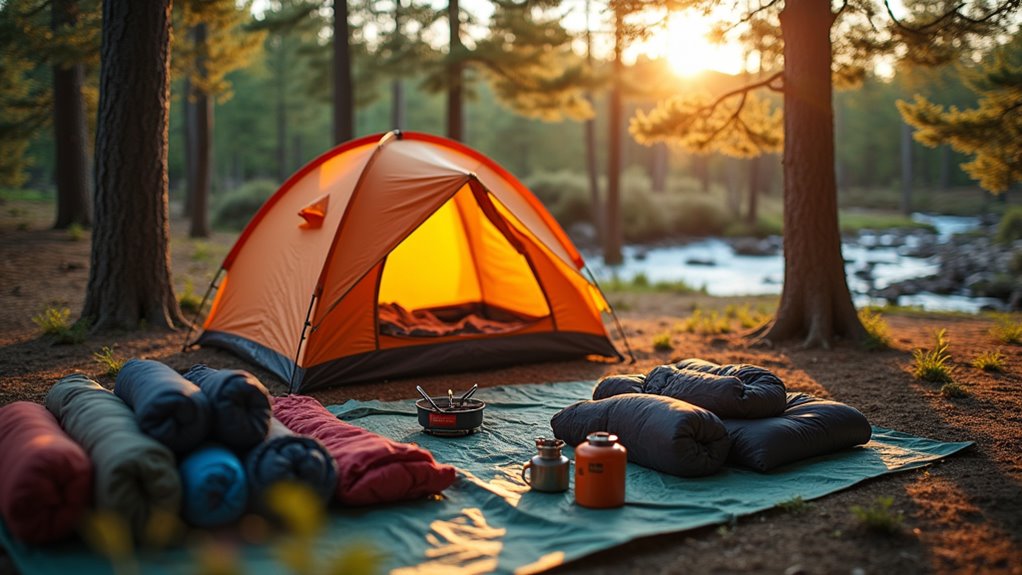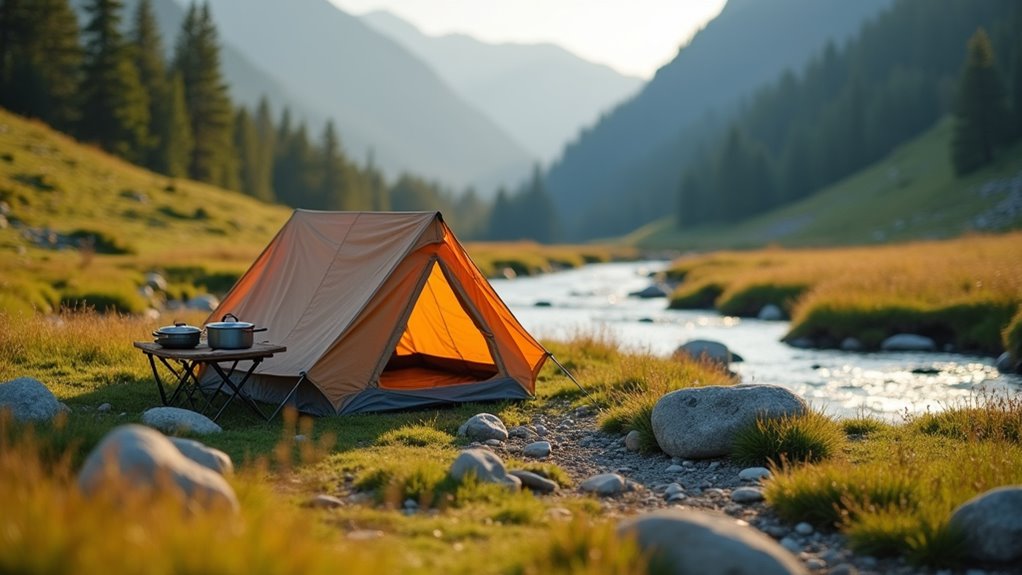Physical Address
304 North Cardinal St.
Dorchester Center, MA 02124
Physical Address
304 North Cardinal St.
Dorchester Center, MA 02124

Avoid camping disasters that ruin your outdoor adventures with these essential tips that will transform your trips into unforgettable experiences.
When Sarah’s family spent their first night shivering in a leaky tent during an unexpected downpour, she realized that successful camping isn’t just about showing up with good intentions. You don’t need expensive gear or years of wilderness experience to avoid common pitfalls that turn dream getaways into uncomfortable ordeals. With the right preparation and a few practical strategies, you’ll transform your outdoor adventures into memorable experiences that won’t break the bank or leave you wishing you’d stayed home.

Before you even pack your gear, you’ll want to scout out the perfect campsite that matches both your experience level and budget. State parks typically offer affordable rates with basic amenities like restrooms and water access—ideal for beginners.
Scout your ideal campsite first—match it to your skill level and budget before even touching your camping gear.
If you’re experienced and seeking solitude, consider dispersed camping on public lands, which is often free but requires self-sufficiency.
Research online reviews and check recent photos to avoid unpleasant surprises. Look for level ground, natural windbreaks, and proximity to water sources without being too close to potential flood zones.
Book popular spots well in advance, especially during peak seasons.
Consider drive-up sites versus hike-in locations based on your gear and physical capabilities. Factor in cell service availability if you need connectivity for emergencies or work obligations.
When evaluating potential sites, prioritize finding an ideal camping spot that offers the right balance of accessibility, safety, and natural beauty for your specific camping style.
Once you’ve secured your ideal campsite, creating a thorough packing list will save you money and prevent forgotten essentials that could ruin your trip. Start with shelter basics: tent, sleeping bag, and pad. Don’t forget a reliable flashlight and extra batteries.
Pack versatile clothing layers rather than bulky items. You’ll need rain gear, warm layers, and moisture-wicking base layers. Multi-use items save space and money—a bandana works as towel, washcloth, or first aid wrap.
Essential supplies include water purification tablets, basic first aid kit, and non-perishable food. Bring a sharp knife, duct tape, and rope for unexpected repairs.
Check weather forecasts before finalizing your gear selection. Consider borrowing expensive items like camping stoves from friends before purchasing your own equipment.
Remember to pack out everything you bring in to follow Leave No Trace principles and preserve the natural environment for future campers.

After arriving at your campsite, establish your camp’s layout before unpacking a single bag—this prevents you from moving heavy gear twice and saves precious daylight hours.
Walk around your site and identify the flattest spot for your tent, keeping it away from potential water runoff areas. Position your cooking area downwind from your sleeping space to avoid smoke drift.
Set up your tent first while you’ve got energy and good light. Stake down corners firmly and adjust guy-lines for stability.
Next, establish your kitchen area on level ground away from foot traffic. Create designated zones for gear storage, keeping frequently used items easily accessible.
Work systematically rather than frantically. You’ll finish faster and won’t forget essential steps like securing loose items before nightfall.
If you’re planning an Alpine getaway, take extra time to secure all equipment against potential mountain weather changes that can develop quickly at higher elevations.
Smart meal planning starts at home, not at the campsite—you’ll save money and avoid the frustration of realizing you’ve forgotten essential ingredients when you’re miles from the nearest store.
Create a detailed menu for each meal, including snacks. Choose simple recipes with minimal prep work and ingredients that won’t spoil quickly.
Pack dry goods in airtight containers to prevent moisture and pests. Use a quality cooler with plenty of ice, keeping raw meat separate from other foods.
Freeze water bottles beforehand—they’ll keep food cold and provide drinking water as they melt.
Pre-cut vegetables and marinate meats at home to reduce campsite prep time. Bring backup meals like instant noodles or canned soup for unexpected situations.
If you’re considering upgrading your camping experience, visiting Britain’s Motorhome Show can provide inspiration and practical solutions for enhanced outdoor cooking and food storage capabilities.

With your meals sorted, you’ll want to master the art of building a proper campfire—it’s your source of warmth, cooking heat, and evening entertainment.
First, check local fire restrictions and use designated fire rings when available.
Gather three types of wood: tinder (dry leaves, paper), kindling (pencil-thick twigs), and fuel wood (thumb-thick to wrist-thick branches).
Build a small nest of tinder, add kindling in a teepee shape, then gradually add larger wood once flames catch.
Never leave your fire unattended, and keep water or dirt nearby for emergencies.
When you’re ready to sleep, pour water over the coals, stir the ashes, and pour more water until everything’s cold to touch.
Remember that campfire safety is always essential and should be your top priority throughout your camping experience.
This prevents costly forest fires.
Weather can shift from sunny to stormy in minutes, so you’ll need a solid emergency plan before heading into the wilderness.
Weather conditions in the wilderness are unpredictable and can turn dangerous quickly, making emergency preparedness absolutely critical for any outdoor adventure.
Pack essential emergency supplies that won’t break your budget but could save your life. Check weather forecasts before departing, but don’t rely solely on predictions – mountain and forest conditions change rapidly.
Always inform someone about your camping location and expected return time. When bad weather strikes during your trip, stay calm and implement your emergency plan rather than panicking or making hasty decisions.

While you’re enjoying nature’s beauty, you’ll want to make certain it remains pristine for future campers by following Leave No Trace principles. Pack out everything you bring in, including food scraps and toilet paper.
Camp only in designated areas or on durable surfaces like rock or gravel to prevent vegetation damage. Keep campfires small and use established fire rings when available. You’ll save money by bringing your own firewood from home rather than buying it locally.
Dispose of wastewater at least 200 feet from water sources by scattering it widely. Keep noise levels down to respect wildlife and other campers. These simple practices cost nothing but ensure camping remains accessible and beautiful for everyone while protecting the environment you’re there to enjoy.
Teaching these Leave No Trace principles to your children helps instill environmental responsibility and makes them better outdoor stewards for life.
Even though you’ve planned hiking and exploration activities, you’ll inevitably have stretches where you’re sitting around camp with time to fill. Don’t let boredom creep in—prepare simple activities that’ll keep everyone engaged without breaking your budget.
Pack lightweight entertainment that doesn’t require electricity or expensive gear. Card games, travel-sized board games, and books weigh almost nothing but provide hours of fun. Consider activities that connect you with nature and your camping companions.
Remember to keep insect repellent handy during evening activities, as mosquitoes and other biting insects are most active during dusk and dawn hours.
As you zip up your tent under a canopy of stars, the crackling campfire casting dancing shadows on weathered rocks, you’ll realize you’ve crafted more than just a getaway—you’ve built memories that’ll outlast your camping gear. With smart planning, respect for nature, and these budget-friendly tips in your back pocket, you’re ready to turn any patch of wilderness into your temporary home. Now grab your sleeping bag and start planning your next adventure.